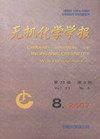锶和钴共掺杂对PrAlO_3钙钛矿氧化物结构和电性能的影响
IF 0.7
4区 化学
Q4 CHEMISTRY, INORGANIC & NUCLEAR
引用次数: 0
摘要
采用柠檬酸盐法结合后续高温烧结制备了新型Sr和Co共掺杂(Pr,Sr)(Al,Co)O3-δ钙钛矿氧化物导电陶瓷。采用XRD、SEM和直流四线法对所得陶瓷的相组成、微观结构和电学性能进行了表征。实验结果表明:制备的Pr0.9Sr0.1Al1-yCoyO3-δ(y=0.1~0.5)陶瓷均为单相菱面体钙钛矿结构,在掺杂范围内,随着y的增加,晶胞体积、相对密度和电导率逐渐增大,电导率的增加速率逐渐减小。此外,这些样品是氧离子和空气中空穴的混合导体,其电导率绝对以p型导电为主。Pr0.9Sr0.1Al1-yCoyO3-δ的电导率随温度的变化可以用小极化子跳变机制来描述。制备的Pr1-xSrxAl0.5Co0.5O3-δ(x=0.1~0.4)陶瓷在x=0.2时明显析出第二相(Pr,Sr) coo3,表明该体系中Sr在a位的固溶极限在10at% ~ 20at%之间,随着Sr含量的进一步增加,样品中的(Pr,Sr) coo3逐渐增加,最终成为主要相。结果表明,Pr1-xSrxAl0.5Co0.5O3-δ陶瓷的电导率在整个温度范围内随x的增加大致呈现先升高后降低的趋势,并在x= 0.3左右达到最大值。此外,当x≥0.2时,样品的导电行为发生了明显的半导体向金属的转变,并且随着Sr含量的增加,转变温度逐渐降低。本文章由计算机程序翻译,如有差异,请以英文原文为准。
Effect of Strontium and Cobalt Co-doping on the Structural and Electrical Properties of PrAlO_3 Perovskite Oxides
Novel Sr-and Co-codoped(Pr,Sr)(Al,Co)O3-δ perovskite oxide conducting ceramics were prepared by citrate process combined with subsequent high-temperature sintering.The phase composition,microstructure and electrical properties of the obtained ceramics were characterized by XRD,SEM and direct current four-wire method.The experimental results show that all the as-prepared Pr0.9Sr0.1Al1-yCoyO3-δ(y=0.1~0.5) ceramics are a single-phase rhombohedral perovskite structure,and their unit cell volumes,relative densities and electrical conductivities increase with increasing y in the doping range,while the increasing rate in electrical conductivity progressively decrease.Furthermore,these samples are a mixed conductor of oxygen ion and hole in air and their electrical conductivities are absolutely dominated by p-type conduction.The temperature dependence of electrical conductivity for Pr0.9Sr0.1Al1-yCoyO3-δ can be described by the small polaron hopping mechanism.For the as-prepared Pr1-xSrxAl0.5Co0.5O3-δ(x=0.1~0.4) ceramics,a second phase(Pr,Sr)CoO3obviously precipitates when x=0.2,indicating that the solid solubility limit of Sr on A site in this system is between 10at% and 20at%,and the(Pr,Sr)CoO3phase in samples increases gradually and finally becomes the main phase with further increase in Sr content.It is found that the electrical conductivity of Pr1-xSrxAl0.5Co0.5O3-δ ceramics roughly exhibits a trend of first increase and then decrease with increasing x in the whole examined temperature range,and reaches the maximum value at around x= 0.3.Additionally,the semiconductor-to-metal transition in the conduction behavior is obviously observed for the samples with x≥0.2,and the transition temperature gradually decreases with increasing Sr content.
求助全文
通过发布文献求助,成功后即可免费获取论文全文。
去求助
来源期刊

无机化学学报
化学-无机化学与核化学
CiteScore
1.40
自引率
42.90%
发文量
8709
审稿时长
2.2 months
期刊介绍:
“Chinese Journal of Inorganic Chemistry” publishes fundamental studies in all phases of inorganic chemistry, including solid-state chemistry, coordination chemistry, inorganic materials chemistry, bioinorganic chemistry, organometallic chemistry, theoretical inorganic chemistry, supermolecule chemistry, applied inorganic chemistry and related field of catalysis. Emphasis is on the synthesis, thermodynamics, kinetics, spectroscopy, structure and bonding properties of new and known compounds.
In addition to full-length research articles, “Chinese Journal of Inorganic Chemistry” also publishes notes, letters, and reviews. “Chinese Journal of Inorganic Chemistry” accepts manuscript written in simplified Chinese or English.
 求助内容:
求助内容: 应助结果提醒方式:
应助结果提醒方式:


